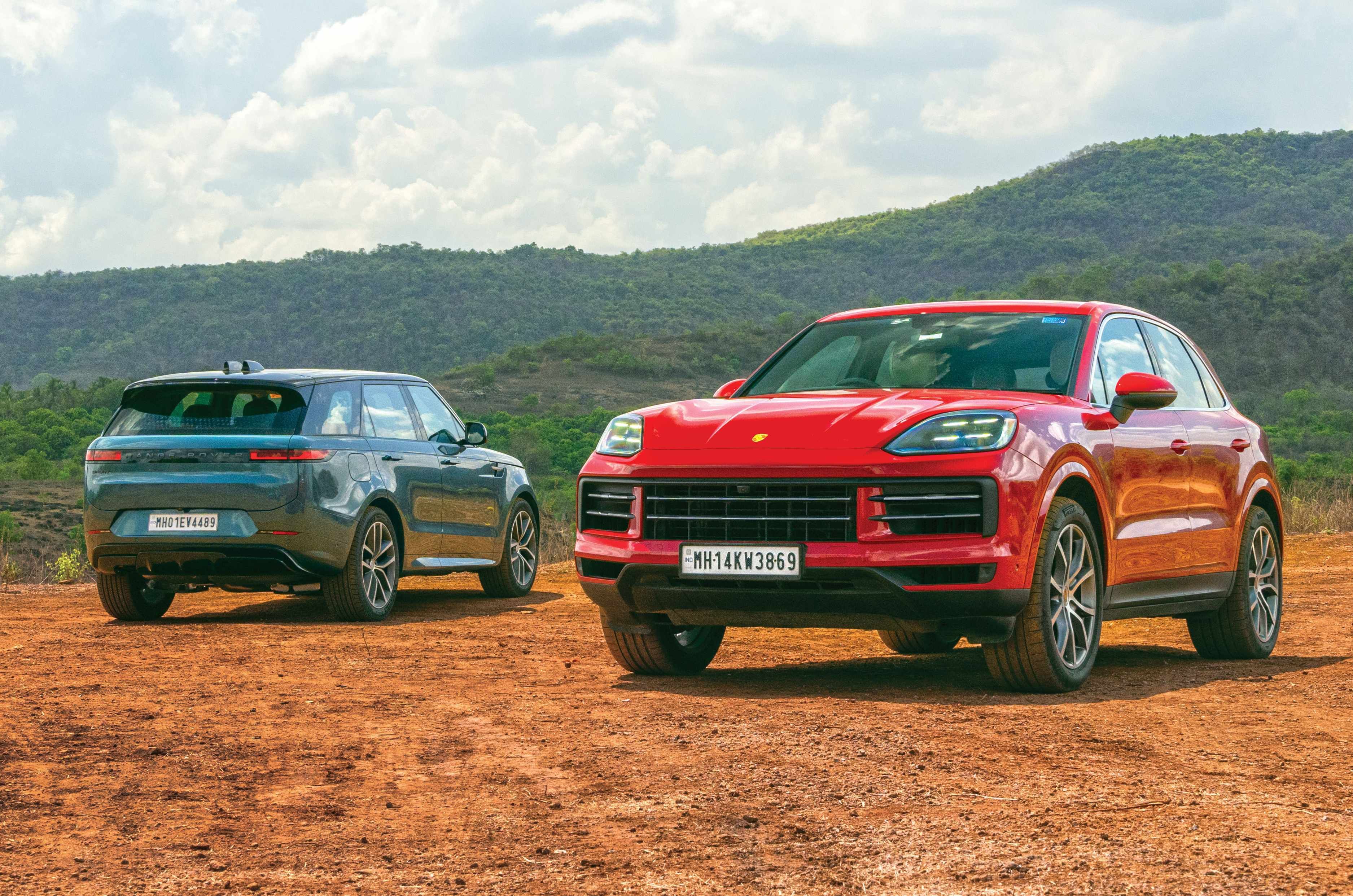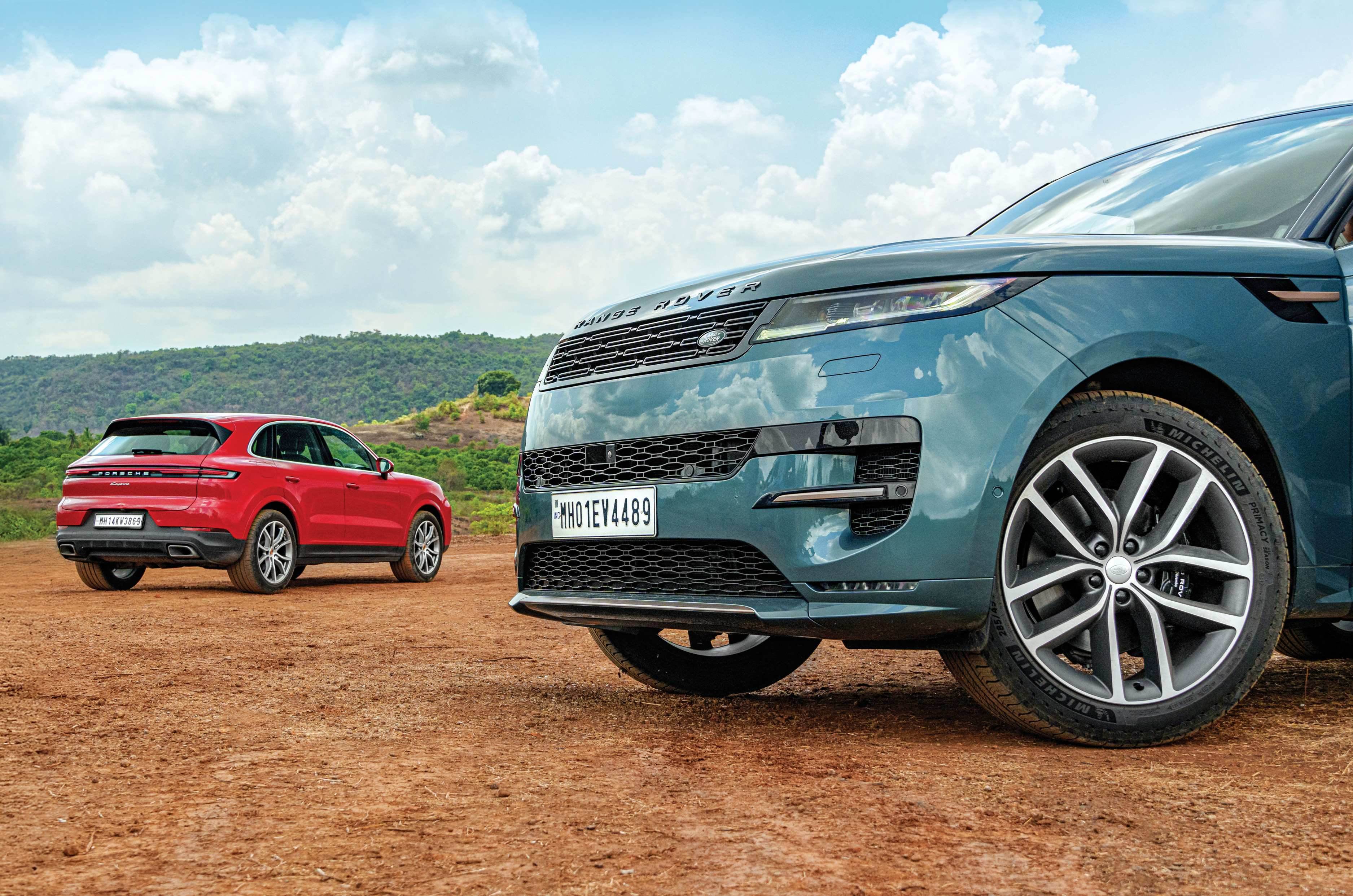
There’s nothing like a big, chunky luxury SUV to tell the world you’ve arrived. None of that compact, entry-level stuff; that’s for common folk. I’m talking big, hulking 5-seaters with 6-cylinder engines that demand proper money – over a crore at least – to show people you do business, and you mean business. The likes of the Mercedes GLE and BMW X5 come to mind, and turning up in either would be a power move. But what if you want to tell the world you’ve arrived… a little further?
There are, of course, plenty of different next rungs on this ladder – a mammoth 7-seater like the X7 or GLS, a luxury MPV if you’re a little left field, a coupé-SUV if you want something sportier, or even an EV if you’re into that sort of thing. But if you want to stick to the formula of a big, 6-cylinder, 5-seat luxury SUV, there are these two.
For around Rs 30 lakh more than the established order, you unlock access to the Range Rover Sport and Porsche Cayenne. Whether their respective badges are posher or give you more clout is up to you, but just what else do they bring to the table, and are they really worth your while?
Range Rover Sport and Porsche Cayenne exterior design
Range Rover Sport built on the same platform as flagship Range Rover

First, some housekeeping. In Land Rover nomenclature, Sport doesn’t mean sporty; it means ‘smaller’ (see also: Discovery Sport). The Range Rover Sport came on the scene in 2005 as a more affordable version of the big Range Rover built on the cheaper platform of the Discovery of the era. It quickly became a force in its own right and, in its next generation, moved to its big sibling’s expensive aluminium platform, becoming larger yet lighter than its predecessor.
This new third-gen model, having learnt from the previous two, has developed its own identity distinct from the bigger Range Rover, with a look that’s altogether more ‘new money’. And, okay, relatively speaking, sportier, too.
But when it comes to sporty SUVs, few are more synonymous with that label than the Porsche Cayenne. It was born of controversy: the first SUV from a sports car brand, which didn’t go down well with purists. What’s more, the original 2002 model was designed, awkwardly, to look like a high-riding 911 – which went down even worse. It had a lot to prove, but boy, did it do it! The looks got more palatable over the generations, the model range grew, and it was – and is – phenomenal to drive on the road.
Cayenne’s styling is quite subtle

Back to the looks, though. While it no longer apes the 911, it still looks distinctly Porsche, thanks to some family design elements. However, Porsche designs are inherently understated, and as such, the Cayenne will fly under the radar of all but car enthusiasts. Most wouldn’t, for example, spot that it runs staggered tyre sizes, with massive 315-section rubber at the rear – high-performance Pirelli P Zero rubber, no less. You can spice things up with paint, wheels and accessories from the options list (oh, we will be revisiting this several times more), but for outright drama and road presence, it simply can’t hold a candle to the Range Rover.
Considerably wider and taller, the Sport commands the entire road with its broad shoulders and boxy shape. JLR India, with local assembly, was wise to go with the nicely loaded Dynamic HSE spec, which includes 22-inch matte grey wheels and bronze accents. It manages to be elegant and imposing at the same time, which is no small feat.
Range Rover Sport and Porsche Cayenne interior and features
Rear seatbacks are reclinable in the Cayenne

Inside, neither is noticeably more spacious than the other big 5-seaters on the market, though perhaps there’s a bit more shoulder room in the wider Range Rover. The Cayenne actually has a bit more knee room in the rear seat, and both seatbacks can be reclined for a bit more room. Both offer 650-plus litres of boot space; again, par for the segment. But those commonalities aside, they go about enticing you in very different ways.
Hauling yourself up over the Range Rover Sport’s tall floor (they’ve left space for the battery of the upcoming EV version) is a task, even at its lowest suspension setting. But once you’re in, there’s no question it goes the extra mile to offer up an elevated luxury experience. Like the exterior, JLR India has specced the interior well, with aniline leather upholstery in rich-looking options of white, brown or burgundy, dark chrome accents and a minimalist design.
Range Rover Sport’s touchscreen integrates most in-car functions

There’s a large touchscreen that’s come at the cost of the superb contextual rotary knobs that JLR itself pioneered; they’ve since been deleted from the Sport’s cabin. You now have to control the AC, drive modes and more from fiddly sliders inside the touchscreen.
Cayenne’s cabin is packed with buttons and knobs

No such issue in the Cayenne’s tactile cabin, which, in true Porsche fashion, puts functionality first. AC controls are knurled switches within easy reach; there’s a big round volume knob front and centre, and drive modes are right where you need them, on the steering wheel itself. And even when you have to use the touchscreen, it’s a simple and logical process with the fewest possible distractions.

That said, while build quality is German-grade impeccable, how flashy the Cayenne’s interior looks depends entirely on how much you’re willing to spend in the options catalogue, and as standard, what you get is a dull grey expanse that’s unexciting to behold. This test car has been specced with the likes of dual-tone leather upholstery and embossed Porsche crests on the seats, and you can go a whole lot further with trims, colours and styling upgrades. You can even have a third screen for the front passenger.
Range Rover Sport feature list is loaded to the gills

While the Cayenne is no longer barebones like it used to be a few generations ago in India (things like 4-zone climate control, air suspension and surround camera with parking assist are now standard), you’ll still have to spend quite a bit to bring it to the same level of features and luxury appointments as the Range Rover. The Dynamic HSE trim for India includes the likes of 22-way heated, ventilated and massaging front seats, a heads-up display, soft-close doors, a Meridian 3D audio system, a rear-entertainment system and ADAS. Pretty much all of this, or their equivalents, can be optioned on the Porsche, too.
Range Rover Sport is a compelling proposition for chauffeur-driven owners

The seats also reflect each SUV’s ethos. Front and rear, you’ll find snugger, more contoured, firmer-cushioned buckets in the sporty Cayenne that will hold you (and three passengers) in place through an enthusiastic sequence of corners. Unfortunately, it makes things less comfy for a fifth person, but that aside, the rear seat is very comfy in its own right. However, if being chauffeured is your use case, you’d be better off in the Range Rover, which feels altogether plusher. You sink into the large, softly padded sofas; front or rear, there’s plenty more width, and thanks to the aforementioned high floor, there’s less intrusion from the transmission tunnel.
Range Rover Sport and Porsche Cayenne ride and handling
Firmer suspension in the Cayenne aids handling
Up front, I find myself lowering the Cayenne’s seat further and further until all I can see are the front fenders rising above the bonnet line. Before even turning a wheel, I’m locked in, hunkered down and ready to seek out some corners, and that alone should tell you what makes this SUV special. Porsche has never shied away from making some compromises in other areas in favour of an optimal driving experience. The steering is heavy, but it’s as tactile as a 911’s; the suspension is firm, but that allows it to corner like a mosquito. These are things that might turn away a conventional luxury car buyer, but a Porsche buyer will understand.

That suspension, incidentally, features air springs with three ride-height settings (medium, low and lower still), but it doesn’t have the soft, floaty nature you might expect. Instead, it’s what we like to call ‘European firm’, the upside of which is unflinching steadiness at 3-digit speeds.
Range Rover Sport’s soft suspension is very comfortable both on and off road
The RR Sport is quite the opposite. Soft, mushy and rolly in all but its Sport setting, its air springs deliver a proper magic-carpet ride, which is particularly impressive for a 2.3-tonne SUV (the Cayenne weighs about 300kg less). Its ride height appears to go from high to higher to highest, topping out at 280mm of ground clearance in its off-road setting. Yes, both of them have off-road modes, but the Range Rover instantly feels more comfortable over the rough stuff, in case that’s part of your buying brief.
The soft suspension does mean it moves around a lot over bumps, and the 22-inch wheels really clunk through potholes, which docks it a few points. On balance, it edges ahead of the firm Cayenne on ride quality, and what helps is that it also feels better insulated than the Porsche.
Range Rover Sport and Porsche Cayenne performance
Cayenne’s V6 leaves much to be desired

Ironically, for the sporty SUV, the weakest link in the Cayenne is the 353hp single-turbo V6 petrol engine. It’s one of the gutsiest tunes of this engine in use across the VW Group, but it is ultimately the base engine for this model and can only carry it so far. In India, we don’t get the S or any of the hybrids, so your next step up is the 500hp V8-powered GTS, which frankly does this brilliant chassis far more justice. The V6 is no slouch, mind; in our tests, it did a brisk 0-100kph sprint of 5.8sec, which is 0.2sec quicker than Porsche’s typically underrated official figure.
Range Rover Sport diesel develops a whopping 700Nm
The RR Sport we have today is the diesel rather than the petrol, but that’s fine for two reasons. One, this clearly isn’t your traditional head-to-head. Two, the diesel is much better suited to the vehicle it is in. Its colossal 700Nm is necessary to move all that mass, and though it’s not quick and responsive like the Cayenne, it feels strong and effortless (0-100 in 6.4sec is not bad either).

The real surprise is that this 3.0-litre straight-6 mild-hybrid diesel powertrain is dripping with character. It doesn’t race to the redline but revs rather smoothly. It sounds soulful (helped by the speakers, no doubt) rather than coarse, and though these two use essentially the same ZF 8-speed torque converter automatic, the tune in the Range Rover is, fittingly, far more relaxed. As with the Cayenne, there is a V8 option – the mighty 635hp SV, but that and other CBU imported variants are much, much more expensive.
Range Rover Sport and Porsche Cayenne price and verdict
Cayenne is fully imported, while Range Rover Sport HSE is locally assembled
That actually is a key difference between these two SUVs – the Porsche is a CBU, and the Range Rover, at least the HSE, is assembled in India. So, while their starting prices are roughly the same, choosing the former gets you a base-spec SUV that you have to option up, whereas the latter is fully loaded right out of the box.
The Cayenne we’re testing is priced at around Rs 1.8 crore, and it can only go up from there. So, while it won’t be winning any VFM contests, just ask a driving enthusiast, and they’ll tell you it’s worth every rupee, and they wouldn’t dream of picking anything else. Some could even find more value in choosing the more powerful GTS, which costs more but also gets more standard equipment.
Range Rover Sport does well on incorporating the wow factor
Conversely, if an owner were to be chauffeur-driven, it should undoubtedly be the Range Rover Sport. It’s a better all-rounder and more of a luxury product that, crucially, nails the all-important wow factor that’s good for impressing peers and strangers alike. Range Rovers have never traditionally been good value, but after local assembly and its reduced price, the Sport is moving closer in that direction, and what helps here is that JLR has not skimped on the features and spec.
It’s clear these two split off in different directions pretty early on in their quest to offer more than the average luxury SUV. They both tug at your heartstrings – the Range Rover with flash and opulence and the Porsche with adrenaline-pumping, ego-boosting driving capability. So, which direction will you arrive in?
| Range Rover Sport vs Porsche Cayenne specs | ||
|---|---|---|
| Range Rover Sport D350 Dynamic HSE | Cayenne | |
| Price (Rs, ex-showroom) | 1.45 crore | 1.48 crore |
| Length (mm) | 4946 | 4930 |
| Width (mm) | 2047 | 1983 |
| Height (mm) | 1820 | 1698 |
| Wheelbase (mm) | 2997 | 2895 |
| Engine | 6 cyls, 2997cc, turbo diesel | V6, 2995cc, turbo petrol |
| Power | 350hp at 4000rpm | 353hp at 6500rpm |
| Torque | 700Nm at 1500-3000rpm | 500Nm at 1450-4500rpm |
| Kerb weight (kg) | 2360 | 2055 |
| Ground clearance (mm) | 216-280 | 193-238 |
| Boot volume (litres) | 647 | 698 |
All prices ex-showroom, India.
Also see:

